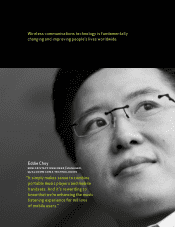Qualcomm 2006 Annual Report Download - page 16
Download and view the complete annual report
Please find page 16 of the 2006 Qualcomm annual report below. You can navigate through the pages in the report by either clicking on the pages listed below, or by using the keyword search tool below to find specific information within the annual report.integrated in an ever-increasing array of innovative devices. Wireless devices now combine the
versatility and capability of a personal computer with true mobility. Enabled by today’s high-speed
networks, the mobile phone is becoming a multi-functional device that supports a myriad of
applications, including voice, data, multimedia and GPS location-based services, using a variety
of wireless networks simultaneously.
strong demand for technology
Among the growth drivers for our business this year is the increasing demand for our chipsets—
semiconductors and system software. In emerging markets like China and India, demand for
inexpensive devices based on 3G technology is increasing. In more established markets like
North America, South Korea, Japan and Europe, consumers and enterprises continue to upgrade
to feature-rich 3G CDMA devices and services.
Global demand for 3G wireless surged this year and QUALCOMM technology continues to be the
key driver with industry-leading solutions targeting all addressable markets. As of November
2006, there were more than 410 million subscribers to QUALCOMM-enabled wireless networks,
including approximately 320 million subscribers to networks based on CDMA2000,® the rst 3G
solution deployed anywhere in the world.
As second-generation (2G) networks make the transition to advanced wireless systems, the
WCDMA (UMTS) market is gaining impressive momentum, presenting an additional opportunity
for us. As of November 2006, there were more than 90 million WCDMA subscribers worldwide.
As we look to future technology deployments, our expertise and continued innovation in CDMA
technology have brought us to a leading position in both CDMA2000 and WCDMA next-generation
innovations. The high-speed version of CDMA2000, 1xEV-DO, is now available on 44 networks in
29 countries. For our WCDMA customers, we were rst-to-market with the enhanced WCDMA next
generation solution called High Speed Downlink Packet Access (HSDPA), and we are pleased that
our chipset customers have been the rst device manufacturers to support HSDPA launches.
The Telecommunications Industry Association adopted our FLO™ technology this year as a
standard for mobile TV. More than 70 leading companies from around the world have now joined
the FLO Forum, the association of wireless industry leaders which drove the FLO standardization
effort. Mobile television may very well be the next “killer” application on the cell phone and we are
excited to see how consumers react to the commercial introduction of MediaFLO™ in 2007 in the
United States.
Each QUALCOMM operating unit plays a key role in innovating and
supporting wireless solutions that enable the wireless industry.
02 qualcomm 2006
























